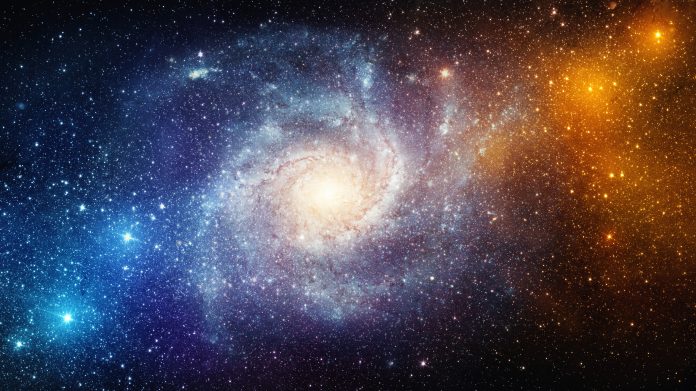Dr John Yardley, Founder and CEO of Threads Software Limited, shares his enthusiasm for cosmology and astrophysics, considering what they are and why we might be interested in them
The current scientific consensus (called The Big Bang Theory) is that the Universe began about 13 billion years ago from something very small — perhaps smaller than a single atom — expanding to something very big. The visible Universe alone contains about 100 billion galaxies, each with about 100 billion stars (one of which is our Sun). It would take 100 billion years for light to travel from the most distant star to the Earth.
In the process of the Universe expanding, stars and galaxies condensed out and, in some of the larger stars, the elements that we see on Earth were formed. These stars exploded and the debris eventually came together in a swirling mass that condensed into a central star and circulating planets just like our solar system.
Any thinking person would rightly ask what came before the Big Bang, and how could it take light eight times longer than the age of the Universe to arrive from the most distant star? Surely that implies that objects move apart faster than the speed of light? To start answering these questions, which defy all our intuitive ideas about space and time, we need to know something about Einstein’s theories of relativity. Fortunately, you don’t need to have a degree in maths or physics to get Einstein’s drift.
Understanding cosmology
Einstein said that a) nothing can travel faster than the speed of light and b) that space is curved. The way to understand curved space is to imagine an Earth the size of the Milky Way. It would be so big that its curvature was too small to measure. It would appear completely flat. Yet if you set off walking in one direction, you would eventually come back to where you started. The Universe is like that too. In theory (if everything stopped moving), if you launched a rocket from the North Pole, it would eventually arrive back at the South Pole. As the surface of the Earth is to two dimensions, so space is to three dimensions.
To help understand, imagine the Earth as a balloon with dots for places. As you inflate it, places become further apart even though they are not actually moving. So too the universe. We can see that all (well nearly all) the other galaxies are moving away from us. From the rate they are moving away from us, we can infer that at some point in the past, they were all bunched together. There is no centre to the Earth’s surface and no centre to the Universe.
Einstein also said that time is relative. A clock on a satellite ticks slower than a clock on Earth. This is a demonstrable fact, and if we didn’t take account of that, satellite navigation would never work. Weird as it may seem, a (hypothetical) clock would stop altogether at the time of the Big Bang. Effectively, time started at the Big Bang, so it makes no sense to ask what happened before it. But that doesn’t stop us feeling a time before the Big Bang should exist.
Last but not least, how do you get something from nothing? Unfortunately, we don’t have the space to answer that here, but answer it we can.
Satellite navigation, a technology that many of us use every day, brings us back down to Earth. It would never have been possible without the study of the nature and origin of the Universe, more generally described as cosmology. Sure, Einstein did this work in the early 1900s and it took 50 years to produce any practical benefits. But without it, we would not be where we are today.
A look at astrophysics
Astrophysics, a branch of cosmology that studies the physics of objects in the universe, has yielded similar benefits. It was long unknown how the Sun, made largely of hydrogen, could have been burning for as long as it took the Earth to develop life. Einstein’s famous equation E=mc2 gave a clue to the answer, and so nuclear power was soon deemed possible, and later still, practically demonstrated.
In the 1960s British astronomer Sir Fred Hoyle and others worked out how all the elements we find on Earth (that includes the necessary constituents of life) could have been manufactured inside stars in exactly the proportions we find them. This calculation was essential to the future understanding of nuclear processes that may one day save the planet.
So, what may seem academic can eventually yield highly practical results. Once you can understand the basic concepts, the next obstacle is having to accept that our everyday experience does not apply to the worlds of the very small (atoms) and the very large (the Cosmos). In both these worlds, particles can appear to move faster than light and appear to be in two places at the same time. Although these appearances run counter to our experience, they can all be explained.
Closing remarks
Not only does an appreciation of cosmology differentiate you from the vast majority of the population, but it is also a fascinating area for study and employment. Many of the methods and technologies developed for academic cosmological research are now heavily used in medicine, engineering and even marketing. And it’s not rocket science.












Good article. I thank you for, writing/publishing it.
I’ve not, previously, heard of this website, so it’s new (and, refreshing), to me.
And you’re right; cosmology and astrophysics are exciting, and pertinent!
(One, small, detail – you said, arrive back at the “South Pole”, when you meant, “North Pole” – regarding the rocket’s return)
The general area of Astronomy is moving faster than any other science: new planets orbiting other stars, the information gleaned from the Hubble Deep Field images of galaxies, etc.
Thanks, again!